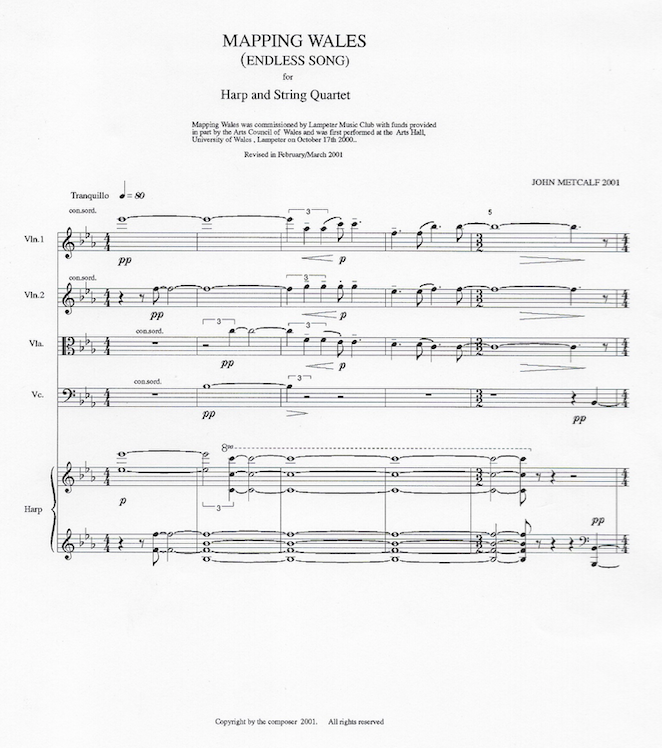Programme Note
Mapping Wales is a set of variations played continuously. The theme is the short original piano work entitled ‘Endless Song’. Aspects of the theme are heard throughout the work and the song is first heard in entirety at the end of the piece.
The title refers to the journeyings and paintings of Welsh artist Catrin Webster and draws similar inspiration from the landscape of Wales and from metaphysical ideas connected with travelling. The piece is just under 20 minutes in length. Some of my other works around this time, like ‘Dances from Forgotten Places’ for String Orchestra, have explored aesthetic areas not commonly associated with contemporary art. Similarly, the mood of ‘Mapping Wales’ is both tender and joyful.
This piece was commissioned to mark the Millennium by Lampeter Music Club, my local music society, with funds made available in part by the Arts Council of Wales. It received its premiere on October 17th, 2000. The harpist Elinor Bennett, who gave the premiere, assisted with the preparation and editing of the solo part. Early in 2001 I prepared a version for harp and string orchestra.
Performance History
First Performance (Quartet version)
University of Wales, Lampeter, Wales
17th October 2000
Maggini String Quartet
Elinor Bennett – harp
First Performance (Orch. version)
Vale of Glamorgan Festival, Cowbridge Leisure Centre, Wales
11th September 2001
English String Orchestra
William Boughton – conductor
Marshall McGuire – harp
European Premiere (Orch. version)
Music Academy Hall, Daugapils, Latvia
21st September 2001
Rigas Kammermusiki
Normunds Sne – conductor
Catrin Finch – harp
World Premiere (version with piano)
Theatr Ardudwy, Harlech, Wales
25th April 2003
Celticana String Quartet
Iwan Llewelyn Jones – piano
Reviews
John Metcalf’s Mapping Wales is an approachable and attractive work – as reflected in its performance history. Commissioned for the Millennium of 2000 it has had some forty or fifty performances since then, in many different countries; it has been recorded twice and broadcast on quite a few occasions. Originally scored for harp and string quartet, this arrangement for harp and small string orchestra is thoroughly engaging; a work in seven sections, shaped as what one might call six variations which finally assemble themselves, as it were, into an underlying theme only stated in the last section. The slow opening was played with an elegant spaciousness, the second section had a sense of a large landscape laid out before the eyes and the third was vivacious in its polyrhythmic patterns; the slow cello tune of the fourth section was well-phrased by Russell Davis and the fifth had a piquant oriental colouring; the attractive theme of the sixth led naturally, via some high harmonics on the strings to the Claire Jones’s eloquent statement of the ‘hidden’ theme. Metcalf’s relatively simple harmonic language and his rhythmic complexities were equally well served by the players of the Welsh Sinfonia and Claire Jones was an impressive and articulate presence throughout. Welsh Sinfonia /Mark Eager (conductor)/Claire Jones (harp). The Temple of Peace, Cardiff 30.1.2011
Glyn Pursglove – musicweb-international
Mapping Wales for harp and strings, originally scored for harp and string quarteti . . . . . is based on a slightly earlier piano piece Endless Song (1999) and the work as a whole may again be experienced as a theme and variations, or – as suggested by Geraint Lewis in his informed insert notes – as ‘variations in search of a theme”. The scoring for harp and strings certainly calls RVW’s Five Variants on “Dives and Lazarus” in manner rather than in actual musical style. The variations are lyrical, meditative and lively, thus providing welcome contrast. A delightful work by any reckoning that should appeal to harpists willing to enlarge their repertoire as a change from the ubiquitous, though beautiful, Danses sacrée et profane of Debussy or the Introduction et Allegro of Ravel.
Hubert Culot MusicWeb International 2008
